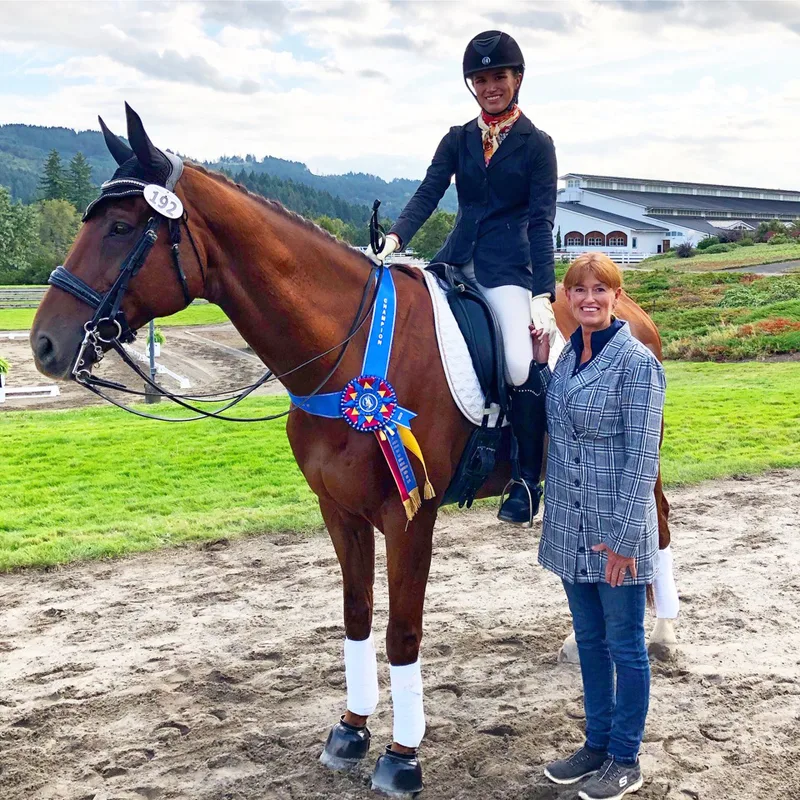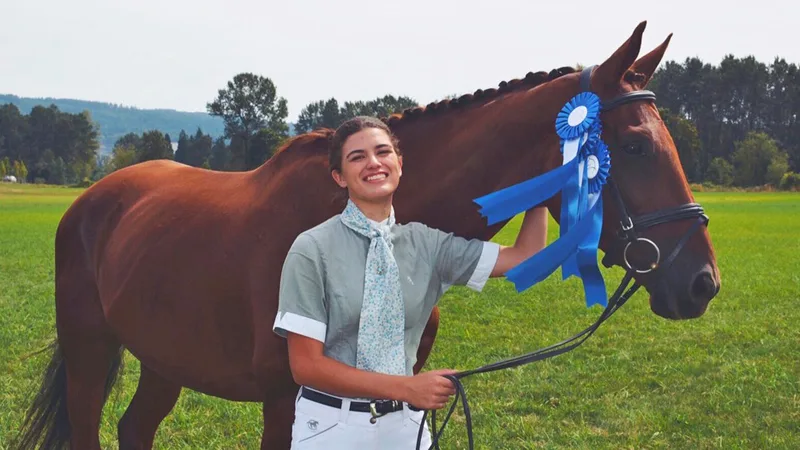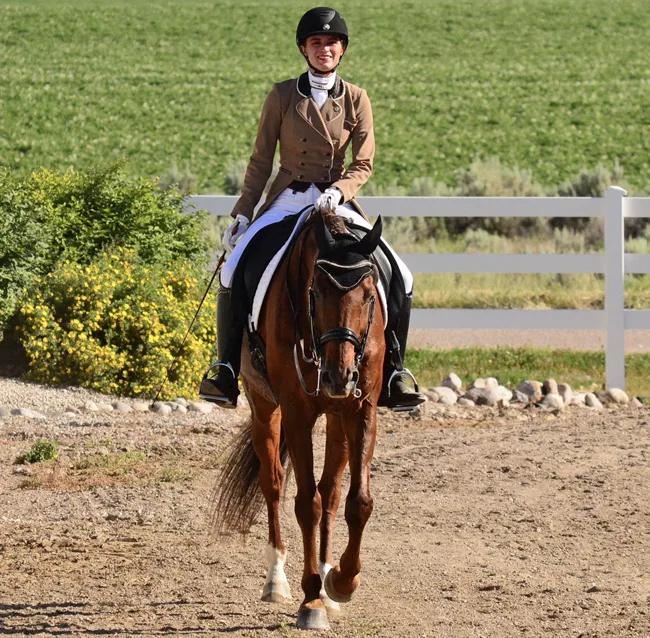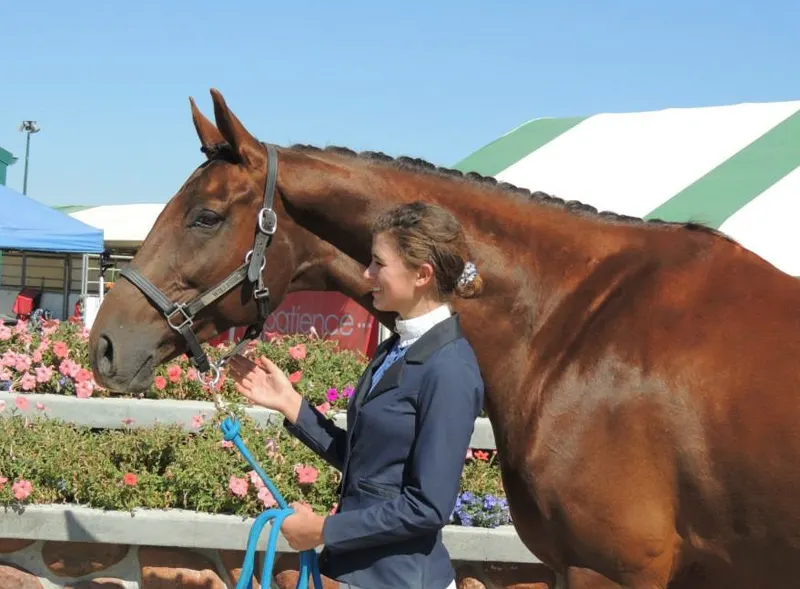They say not to look a gift horse in the mouth, but every equestrian knows you’d better look twice at its legs. Which is why Jesse Woodhead understood she’d need to proceed with caution when her mom, dressage trainer Marina Parris-Woodhead, told her about Waldor.
“Waldor had sustained a high suspensory injury as a 7-year-old, and his owner had spent more than a year trying to rehab him,” said Woodhead.
Kindra Smith Wilson made every effort to help “Willis” heal, but despite top-notch veterinary care, he wasn’t a cooperative patient. He hated standing in a stall and developed ulcers during his recuperation. While he eventually came sound under tack, he wouldn’t pass a pre-purchase exam, so Wilson, who was a friend of Parris-Woodhead, offered to give Willis to her.
“Because she was having to board him at a facility it was getting increasingly difficult for her to justify keeping him and affording his care,” said Woodhead. “She thought maybe I could learn something on him because he had been doing third level and had a change and everything, where I was only riding first level. So, the deal was, I could take him on as essentially a rehab project, and if he wasn’t sound enough for work, we would retire him at pasture.”

Jesse Woodhead wasn’t sure how much she’d be able to do with Waldor or if she could ever compete him when she first started riding him in 2013. Photos Courtesy Of Jesse Woodhead
Woodhead jokes that she started riding in the womb. She grew up in Kansas City, the youngest of three children and the only one to take an interest in the family business. She started competing in dressage on her first pony, Max, during elementary school, and in middle school she graduated to a Quarter Horse named Bob.
The family had moved to Joseph, Oregon, when they went to try Willis. At 15, Woodhead was immediately smitten with the American Warmblood gelding (Wagnis—Honest Dulcinea, Honest To God) bred by Jana Wagner.
“I just fell in love with him,” Woodhead said. “I loved his character, I loved his movement, and I really loved how safe he felt. They let me trail ride him around the facility after our test ride, and I came back and said I really, really liked him.”
When Parris-Woodhead explained Wilson’s offer, Woodhead said yes immediately.
“I knew I would have to be patient; I knew he might never compete,” Woodhead admitted. “But he was my first big girl horse—my first warmblood! That was exciting enough for me. I still had my Quarter Horse who I continued to do some 4-H stuff with, but I never really worried about falling behind my peers. I was just really dedicated to Willis.”
While Willis was sound when he arrived at the Woodheads’ facility in 2013, they committed to rehabbing him as if he weren’t.
ADVERTISEMENT
“By the time I got him, vets were minimally involved,” said Woodhead. “At first, I just had to do a lot of walking. We thought that would help his rehab. Plus, I really wanted to ride him all the time even if I couldn’t do much. So, we just walked and walked. It was an incredible learning opportunity for me because while we were walking, I was learning how to make him round and connected; I was learning lateral movements, schooling shoulder-in and haunches-in and half-pass—all these things I had never done before. And the whole time, he was getting stronger.”
For all she learned in the saddle, Woodhead says much of her education with Willis happened out of the tack.
“After every ride I would cold hose him for 10 minutes, minimum,” Woodhead said. “Then I would wrap, usually with a poultice. My mom taught me a lot of what I needed to do, and I took it on myself to be really diligent. I was always afraid that if I skipped one day, that one day would erase everything we’d worked toward. I knew that whatever I did, it helped. That meant that whatever I skipped might hurt.”
The Woodheads rehabbed Willis through feel and by paying careful attention to any sign of swelling or change in his stride length. They didn’t have a veterinarian ultrasound him, but they did work closely with journeyman farrier Skip Carlsgaard, and Jeff Moore did—and continues to do—regular massage and chiropractic work to manage muscle pain and compensation in his loins from his injury
They worked hard to manage every aspect of Willis’ care. Because he became claustrophobic in a stall and developed ulcers, they kept him outside. “He had to cross a cold creek every day to get to his hay, and I honestly think that low impact moving around really helped solidify his rehab,” said Woodhead. “I still manage his ulcers with aloe juice and Ulcergard when needed.”
The lessons learned while caring for Willis gave Woodhead a great education in managing a high-performance athlete.
“Willis taught me so much as a young rider about how the legs work, about gut health, really just horse health in general,” Woodhead said. “Horses are athletes, and they deserve to be treated that way. Their muscles and tendons can heal with the right balance of hot and cold and stress.
“Some days I would get on, and I just had to say, ‘Hmm, doesn’t seem quite right. We better just walk today,’ ” she continued. “Through doing that we just started progressing, and I always let him take the winters off so I wouldn’t pressure him too much.”
After more than a year of slow, progressive training, Woodhead and Willis did their first U.S. Equestrian Federation competition together in July of 2014.

Jesse Woodhead (left) and Marina Parris-Woodhead worked together to slowly rehabilitate Waldor from a high suspensory injury so he could return to the show ring.
“He’s fantastic at a competition—like hop off the trailer, stick your foot in the stirrup and go fantastic,” Woodhead said. “It’s like he knows he’s there to kick butt. He goes into this whole other mode where he’s pumped up and super focused, so nothing fazes him. We’ve been in busy warm-ups with other horses to dodge around; we’ve shown in the rain, with dogs barking, big atmosphere, and he doesn’t care about any of it.
ADVERTISEMENT
“It’s always nice to have that, but it was especially nice as a young rider,” Woodhead continued. “I could just drop my reins and relax and really focus on my test.”
Woodhead and Willis climbed the levels, competing in four regional championships beginning in 2014. In 2017, Woodhead earned her U.S. Dressage Federation bronze medal.
“We kind of thought that was as far as he was going to be able to go,” Woodhead said. “But he just told me he wanted to do more. Every year since then he offers himself up to the upper-level movements. He shows great talent for the half-steps and one-tempis already. So, I’ve always said, he’ll tell me when he’s ready to slow down, but for now, he wants to keep going and keep getting stronger. It’s gotten to the point the vets can’t even find the injury anymore. If you didn’t tell them which leg, they never would be able to guess.”

Jesse Woodhead couldn’t contain her smile after earning the scores for her USDF bronze medal with Waldor.
Now 22, Woodhead became an official assistant trainer to her mom this year at their farm, Hidden Oaks Horses. She celebrated her transition from junior to open rider with a new shadbelly.
“This year we debuted at Prix St. Georges, and I got my scores for my silver medal,” Woodhead said. “At regionals we won our fourth level freestyle and came in third in the Prix St. Georges open, which I was thrilled about. Now that we’re home and it’s off season, we’re just slowly working toward Intermediaire I, taking it one day at a time.”
Woodhead applies the same skills she learned with Willis, who is 15 now, to her clients’ horses—cold hosing after every workout, wrapping for any heat or swelling, and paying scrupulous attention to any sign of pain. Sometimes that means untacking early.

Jesse Woodhead said making her Prix St. Georges debut and earning the scores for her USDF silver medal with Waldor are her biggest achievements to date.
“The beauty of dressage is you’re never going to be perfect anyway, so your timeline can be a little bit endless,” Woodhead said. “Whatever you’re working on, you’re probably still going to be working on it in another month or year or 10 years, so you really shouldn’t ever feel rushed to get to any one point. You really have to stop and take a breath and take it day by day, enjoy every ride, and commit to your horse’s care.
“By doing that, you’ll not only reach your goal, but you’ll also feel pride in what you’re doing in the present,” she added. “That’s so much better, I think, than getting caught up in what you might achieve in the future.”
Do you know a horse or rider who returned to the competition ring after what should have been a life-threatening or career-ending injury or illness? Email Kimberly at kloushin@coth.com with their story.















